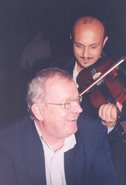 Or how to learn from a toolkit...?My father was a first violinist in the Symphony Orchestra of our town and a teacher at the local Conservatorium. He had studied with Carl Flesch and Oscar Back, both born in Hungary. And through a lineage of teachers – Joseph Marsick, Eugene Ysaye, Hubert Leonard, Henri Wieniaswki, Rodolphe Kreutzer, Giambatista Viotti - to name a few, he traced his basic knowledge and skills back to Giuseppe Tartini (1692-1770, picture). I was five when he started to teach me – my initiation into a lineage of communicators that I now pass on in quite a different way and quite a different context.
Or how to learn from a toolkit...?My father was a first violinist in the Symphony Orchestra of our town and a teacher at the local Conservatorium. He had studied with Carl Flesch and Oscar Back, both born in Hungary. And through a lineage of teachers – Joseph Marsick, Eugene Ysaye, Hubert Leonard, Henri Wieniaswki, Rodolphe Kreutzer, Giambatista Viotti - to name a few, he traced his basic knowledge and skills back to Giuseppe Tartini (1692-1770, picture). I was five when he started to teach me – my initiation into a lineage of communicators that I now pass on in quite a different way and quite a different context.I studied the works of many of the lineage gurus and listened to the stories how they had explained difficult techniques. How to make a beautiful tone, how to catch the attention of the audience, how to change their mood. Stories how many hardships they had endured, how they had overcome difficulties in their practice. But also about their travels and adventures. Many stories were about how later in their career they had learned from the concerts of famous violinists they attended: Fritz Kreisler, Joseph Joachim, Nicolo Paganini, etc.
 I experienced that 80% of my education was just practicing with my nose into the violin, my eyes on the notes of the Cevcik, Mazas or Kreutzer Studies, my mind controlling fingers and arms and my ears trying to catch a wrong note. 20% was demonstrating my progress in front of the teacher and listening to his instructions, comments or demonstrations. How nice if he played the same difficult study with me and the sound of the two violins camouflaged my own shortcomings. Then comes playing with other students, imitating them, competing with them.
I experienced that 80% of my education was just practicing with my nose into the violin, my eyes on the notes of the Cevcik, Mazas or Kreutzer Studies, my mind controlling fingers and arms and my ears trying to catch a wrong note. 20% was demonstrating my progress in front of the teacher and listening to his instructions, comments or demonstrations. How nice if he played the same difficult study with me and the sound of the two violins camouflaged my own shortcomings. Then comes playing with other students, imitating them, competing with them.My interest in communication and learning goes back to these years I learned to play the violin. I know now that to begin with you need the sparkle in the eye of your teacher. You need his encouragement, his admonishments, his inspiration. Once formal education has set you on your way and you practice hard, informal education starts adding value. Peer exchange. New books. New experiences. Lifelong learning. In this process, I learned, a smile is an indicator of success.
The toolkit offers different learning opportunities. Maybe you are facing in your work a specific issue or question. Zap through the toolkit and you may come across relevant fact sheets, examples or checklists. Maybe you are engaged in a professional dialogue with a colleague and decide, lets see what the toolkit says about this. Maybe you use parts of the toolkit in a training workshop. Maybe the toolkit inspires you to start you own blog or web community. If the toolkit can trigger a smile, you know you are right. Otherwise never mind.









2 comments:
have had a quick look at the Toolkit. 331 pages is rather a lot to comment on quickly. My first reaction and question is, "How do you expect practioners to use such a lengthy document". I more or less reached the conclusion that the best way to learn how to cook is for my wife to show me, and the same goes for communication especially when trying to persude senior management to take it seriously. I have not read the Toolkit introduction, but I guess how it will be used is the first question.
As I mailed you earlier thanks very much for your reaction. Feedback is always welcome. I agree that in terms of learning the toolkit as stand alone intervention is not very adequate. The CBD CEPA work program positions the toolkit as one of the interventions to strengthen communication capacities. Others are regional and national workshops and forms of coaching. The toolkit is meant to provide a basket from which to pick some basic tools for such workshops, based on specific needs and demand of participants.
Post a Comment